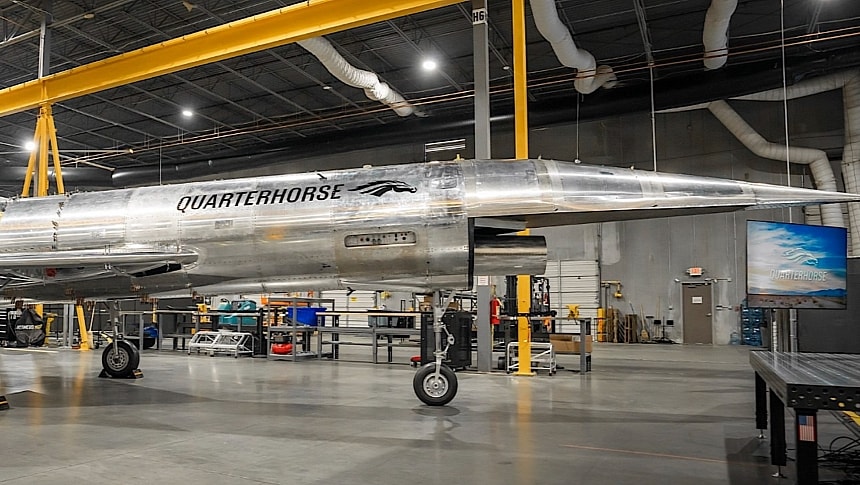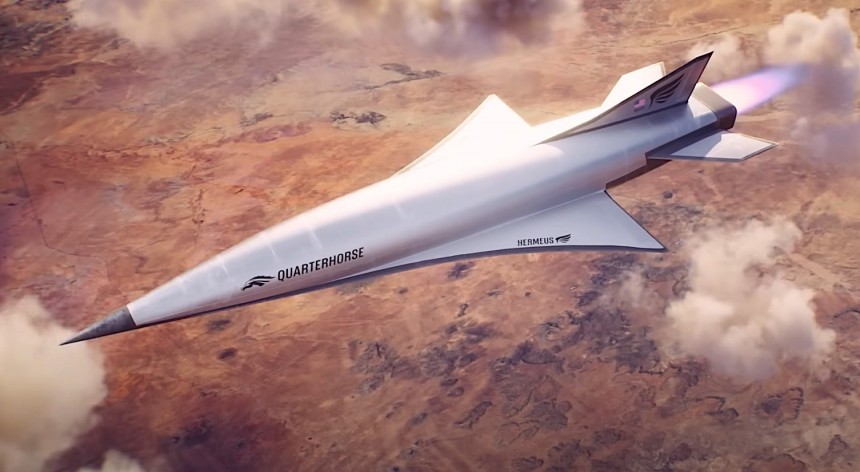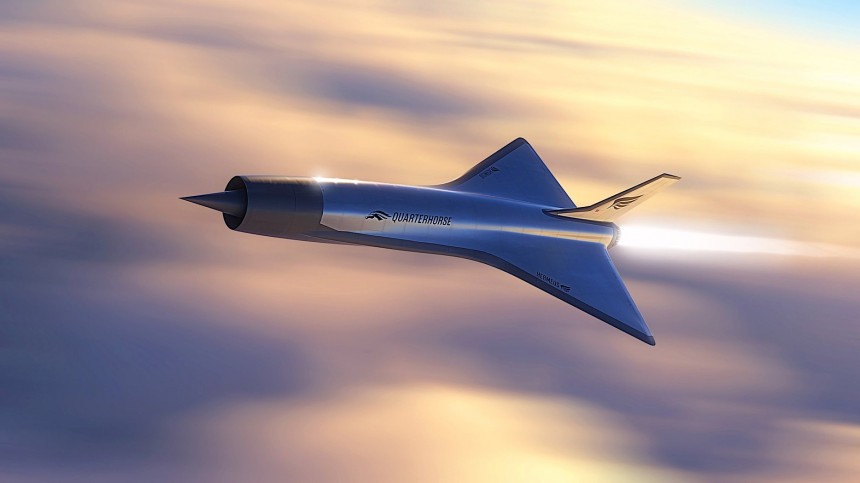Many of today's active adults were not even alive, or they were very young at best, back when the absolute speed record for a crewed aircraft flying in Earth's atmosphere was set.
That happened back in 1976, when an American SR-71 Blackbird spy plane shot through the sky at Mach 3.3, which in numbers we all understand translates into 2,193.2 mph (3,529.6 kph). It's a record that has endured for decades, but it will soon become the target of a new generation of aircraft: hypersonics.
Technically speaking, for something to be considered hypersonic it would have to travel at speeds of over Mach 5 (3,800 mph/6,100 kph). It is something space rockets can easily do (in fact, they easily reach Mach 25), but not a feat aircraft, especially crewed ones, can easily achieve.
And yet that's exactly what a number of aviation startups are working on, in the hopes they will make travel, both military or civilian, a lot easier and faster. Among them is a company called Hermeus.
Born back in 2018, the Georgia-based group is dreaming no more no less of a hypersonic airliner capable of transporting people at insane Mach 5 speeds. That would be enough to take humans from New York to London in under 90 minutes!
The aircraft is called Halcyon, and it is a project so radical that it doesn't even have an exact launch date. To some observers it even kind of seems to have gotten sidetracked over the past few years.
That's because ever since its birth the company has gotten on the American military's radar, which it is now anxiously waiting for something called the Darkhorse. That would be a "multi-mission hypersonic UAS (uncrewed aerial system) designed for defense and national security missions," but also the "world’s only purpose-built high-Mach drone."
Because of the military's interest, but also because it's easier to design a drone before a crewed aircraft, it is the Darkhorse that will probably arrive into the world ahead of the airliner. And it seems Hermeus is making giant leaps toward getting the Darkhorse ready sooner than expected.
Back in January Hermeus introduced us to something called the Quarterhorse Mk 0. It was described as a fully integrated vehicle, the first in the Quarterhorse family that would precede the hypersonic Darkhorse and, in essence, the forefather of the Halcyon.
Mk 0 was a testbed to see how all major aircraft subsystems work in a real-world environment, and it was never meant to fly. It did, however, demonstrate the remote-controlled and communications systems, taxiing, and pilot-in-the-loop steering and controls.
The machine was put through its paces at the Arnold Engineering Development Complex (AEDC) in Tullahoma, Tennessee, and the images provided by the company showed something that was nothing more than a jet engine on wheels.
Not the same can be said about the Quarterhorse Mk 1 which was presented this week. As Hermeus' second fully-integrated aircraft to be presented over the past year, this one is the real deal, as it's meant to actually take to the sky and put both the Darkhorse and the Halcyon on track to becoming a reality.
Put together in just seven months, the aircraft kind of looks like the experimental planes of the 1950s, minus the space for a pilot: long and pointy like a missile, with relatively small wings, and completely unpainted (you can see it in the main photo of this piece).
Just like the MK 0, Mk 1 will be remote-controlled, and it will use a General Electric J85 jet engine – the same powerplant deployed on several other past experimental machines, but also on the T-38 Talon trainer.
Hermeus does not say anything about the capabilities of the powerplant in this configuration, nor are we given any other details about the plane.
We do know it will now enter a series of ground tests in preparation for it taking to the sky later in the year. The main mission of the Mk 1 is to "demonstrate high-speed takeoff and landing," and it will do so at Edwards Air Force Base in California.
If all goes well with this one, Hermeus will launch Quarterhorse Mk 2. That test aircraft will be powered by the Pratt & Whitney F100 engine, the same one deployed on the world-famous fighter jets F-15 and F-16. The Mk 2 will be the one actually to try and go supersonic, in a flight test currently scheduled for next year.
It's unclear just how many Quarterhorses we'll get to see before the hypersonic drone can evolve from them, but Hermeus promises "each aircraft in the Quarterhorse program progressively increases in complexity."
We will, of course, keep an eye on further developments and report back once we learn more. After all, it's not every day we get to witness aviation history being written.
Technically speaking, for something to be considered hypersonic it would have to travel at speeds of over Mach 5 (3,800 mph/6,100 kph). It is something space rockets can easily do (in fact, they easily reach Mach 25), but not a feat aircraft, especially crewed ones, can easily achieve.
And yet that's exactly what a number of aviation startups are working on, in the hopes they will make travel, both military or civilian, a lot easier and faster. Among them is a company called Hermeus.
Born back in 2018, the Georgia-based group is dreaming no more no less of a hypersonic airliner capable of transporting people at insane Mach 5 speeds. That would be enough to take humans from New York to London in under 90 minutes!
The aircraft is called Halcyon, and it is a project so radical that it doesn't even have an exact launch date. To some observers it even kind of seems to have gotten sidetracked over the past few years.
That's because ever since its birth the company has gotten on the American military's radar, which it is now anxiously waiting for something called the Darkhorse. That would be a "multi-mission hypersonic UAS (uncrewed aerial system) designed for defense and national security missions," but also the "world’s only purpose-built high-Mach drone."
Back in January Hermeus introduced us to something called the Quarterhorse Mk 0. It was described as a fully integrated vehicle, the first in the Quarterhorse family that would precede the hypersonic Darkhorse and, in essence, the forefather of the Halcyon.
Mk 0 was a testbed to see how all major aircraft subsystems work in a real-world environment, and it was never meant to fly. It did, however, demonstrate the remote-controlled and communications systems, taxiing, and pilot-in-the-loop steering and controls.
The machine was put through its paces at the Arnold Engineering Development Complex (AEDC) in Tullahoma, Tennessee, and the images provided by the company showed something that was nothing more than a jet engine on wheels.
Not the same can be said about the Quarterhorse Mk 1 which was presented this week. As Hermeus' second fully-integrated aircraft to be presented over the past year, this one is the real deal, as it's meant to actually take to the sky and put both the Darkhorse and the Halcyon on track to becoming a reality.
Put together in just seven months, the aircraft kind of looks like the experimental planes of the 1950s, minus the space for a pilot: long and pointy like a missile, with relatively small wings, and completely unpainted (you can see it in the main photo of this piece).
Hermeus does not say anything about the capabilities of the powerplant in this configuration, nor are we given any other details about the plane.
We do know it will now enter a series of ground tests in preparation for it taking to the sky later in the year. The main mission of the Mk 1 is to "demonstrate high-speed takeoff and landing," and it will do so at Edwards Air Force Base in California.
If all goes well with this one, Hermeus will launch Quarterhorse Mk 2. That test aircraft will be powered by the Pratt & Whitney F100 engine, the same one deployed on the world-famous fighter jets F-15 and F-16. The Mk 2 will be the one actually to try and go supersonic, in a flight test currently scheduled for next year.
It's unclear just how many Quarterhorses we'll get to see before the hypersonic drone can evolve from them, but Hermeus promises "each aircraft in the Quarterhorse program progressively increases in complexity."
We will, of course, keep an eye on further developments and report back once we learn more. After all, it's not every day we get to witness aviation history being written.




















